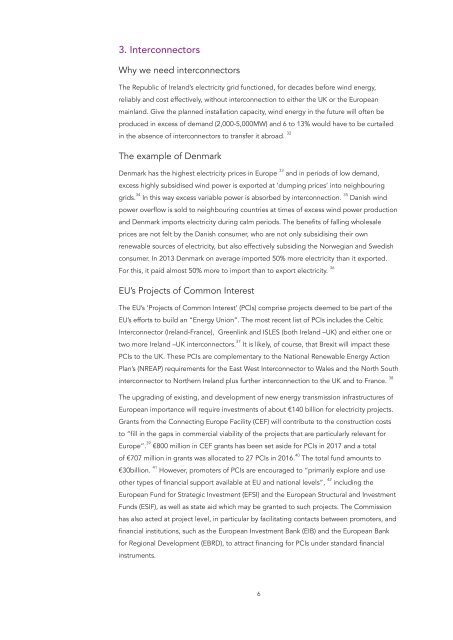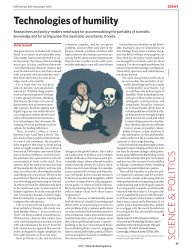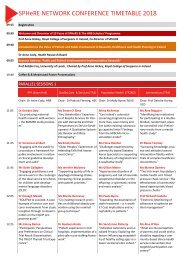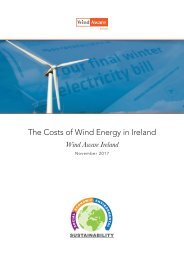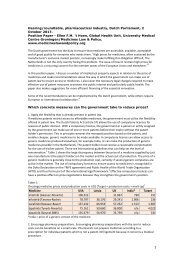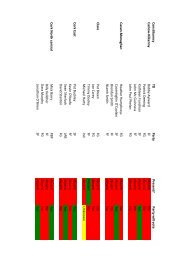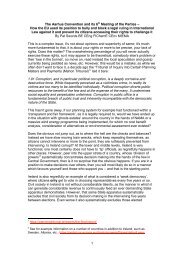Costs of Wind Energy Report
You also want an ePaper? Increase the reach of your titles
YUMPU automatically turns print PDFs into web optimized ePapers that Google loves.
3. Interconnectors<br />
Why we need interconnectors<br />
The Republic <strong>of</strong> Ireland’s electricity grid functioned, for decades before wind energy,<br />
reliably and cost effectively, without interconnection to either the UK or the European<br />
mainland. Give the planned installation capacity, wind energy in the future will <strong>of</strong>ten be<br />
produced in excess <strong>of</strong> demand (2,000-5,000MW) and 6 to 13% would have to be curtailed<br />
in the absence <strong>of</strong> interconnectors to transfer it abroad. 32<br />
The example <strong>of</strong> Denmark<br />
Denmark has the highest electricity prices in Europe 33 and in periods <strong>of</strong> low demand,<br />
excess highly subsidised wind power is exported at ‘dumping prices’ into neighbouring<br />
grids. 34 In this way excess variable power is absorbed by interconnection. 35 Danish wind<br />
power overflow is sold to neighbouring countries at times <strong>of</strong> excess wind power production<br />
and Denmark imports electricity during calm periods. The benefits <strong>of</strong> falling wholesale<br />
prices are not felt by the Danish consumer, who are not only subsidising their own<br />
renewable sources <strong>of</strong> electricity, but also effectively subsiding the Norwegian and Swedish<br />
consumer. In 2013 Denmark on average imported 50% more electricity than it exported.<br />
For this, it paid almost 50% more to import than to export electricity. 36<br />
EU’s Projects <strong>of</strong> Common Interest<br />
The EU’s ‘Projects <strong>of</strong> Common Interest’ (PCIs) comprise projects deemed to be part <strong>of</strong> the<br />
EU’s efforts to build an “<strong>Energy</strong> Union”. The most recent list <strong>of</strong> PCIs includes the Celtic<br />
Interconnector (Ireland-France), Greenlink and ISLES (both Ireland –UK) and either one or<br />
two more Ireland –UK interconnectors. 37 It is likely, <strong>of</strong> course, that Brexit will impact these<br />
PCIs to the UK. These PCIs are complementary to the National Renewable <strong>Energy</strong> Action<br />
Plan’s (NREAP) requirements for the East West Interconnector to Wales and the North South<br />
interconnector to Northern Ireland plus further interconnection to the UK and to France. 38<br />
The upgrading <strong>of</strong> existing, and development <strong>of</strong> new energy transmission infrastructures <strong>of</strong><br />
European importance will require investments <strong>of</strong> about €140 billion for electricity projects.<br />
Grants from the Connecting Europe Facility (CEF) will contribute to the construction costs<br />
to “fill in the gaps in commercial viability <strong>of</strong> the projects that are particularly relevant for<br />
Europe”. 39 €800 million in CEF grants has been set aside for PCIs in 2017 and a total<br />
<strong>of</strong> €707 million in grants was allocated to 27 PCIs in 2016. 40 The total fund amounts to<br />
€30billion. 41 However, promoters <strong>of</strong> PCIs are encouraged to “primarily explore and use<br />
other types <strong>of</strong> financial support available at EU and national levels”, 42 including the<br />
European Fund for Strategic Investment (EFSI) and the European Structural and Investment<br />
Funds (ESIF), as well as state aid which may be granted to such projects. The Commission<br />
has also acted at project level, in particular by facilitating contacts between promoters, and<br />
financial institutions, such as the European Investment Bank (EIB) and the European Bank<br />
for Regional Development (EBRD), to attract financing for PCIs under standard financial<br />
instruments.<br />
6


